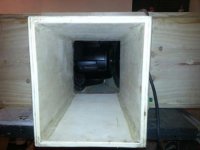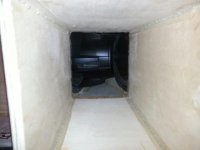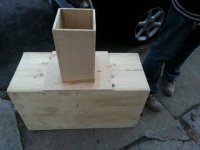What's the name and model of the car amp?
Audiopipe APCL-15001D
I have two of them
APCL-15001D - 1500 Watt Mono Class D Amplifier
That amp is stable into 1ohm loads with 1500watts into 1ohm. You can connect each side in parallel and then series the two drivers for a 2ohm load overall which puts this at 750watts. Or tie each side in parallel and driver each side with its own amp for 3000 watts total.
Are those specs for real 1500 watts into 1ohm? Maybe they are taking crest factor of 6dB so real output is 375w continuous into 1ohm? Specs say "continuous power".
That amp is stable into 1ohm loads with 1500watts into 1ohm. You can connect each side in parallel and then series the two drivers for a 2ohm load overall which puts this at 750watts. Or tie each side in parallel and driver each side with its own amp for 3000 watts total.
Are those specs for real 1500 watts into 1ohm? Maybe they are taking crest factor of 6dB so real output is 375w continuous into 1ohm? Specs say "continuous power".
https://www.google.com/search?q=apc...d&sa=X&ei=DuR4VJTEO5HbsASMnoKoDQ&ved=0CAYQ_AU
2,810 watts @ 0.5 ohms!!!
2,810 watts @ 0.5 ohms!!!
https://www.google.com/search?q=apc...d&sa=X&ei=DuR4VJTEO5HbsASMnoKoDQ&ved=0CAYQ_AU
2,810 watts @ 0.5 ohms!!!
In this video they put the amp on a dyno and it clocked 2753watts (dynamic burst) into 0.5ohms !!!! For $167 that is some crazy performance. I think 2 ohms continuous was 948 watts.
Very impressive.
Audiopipe APCL-15001D Amp Dyno FULL Test RMS Wattage - YouTube
We should use this for home or pro audio just add lead acid battery and charger. 🙂
Last edited:
Hi guys
Thanks for all the information you guys post. I am finish with the box, it was fun building it.
I fired up and it sound nice, real nice.
I think my girlfriend is jealous. LOL
View attachment 451215
View attachment 451216
View attachment 451217
Congratulations! How did you end up wiring it? And did you try it in a room without the extension duct and did you try it in the car yet?

You have a girlfriend who likes audio? A real keeper😀
Congratulations! How did you end up wiring it? And did you try it in a room without the extension duct and did you try it in the car yet?
You have a girlfriend who likes audio? A real keeper😀
I wired it at 8 ohm. i will strap the two amps to together.
I think it sound better with the duct.
I did not try it in the car yet.
She is a bass head.lol
Her car stereo is also up loud.
It won't help and may hurt with rsonance peak. I won't know until I sim it. How much of a flare do you want and why do you want a flare? It should air flush with seat back.
Lawbiding,
Do you have a measurement mic? It would be great if you could make a measurement in an open field or parking lot at 1m and 2.83v so I can see how well the sim worked. Also useful is measurement at very low power with mic at exit plane of port or mouth. If you want to get serious about speaker building, a mic is indispensable. I use the Dayton UMM-6 and REW software.
If you can upload a video with sheet of paper at the mouth or duct flapping with deep bass playing that would be cool to see.
Do you have a measurement mic? It would be great if you could make a measurement in an open field or parking lot at 1m and 2.83v so I can see how well the sim worked. Also useful is measurement at very low power with mic at exit plane of port or mouth. If you want to get serious about speaker building, a mic is indispensable. I use the Dayton UMM-6 and REW software.
If you can upload a video with sheet of paper at the mouth or duct flapping with deep bass playing that would be cool to see.
Download REW and try it. Very easy. Even if mic is not calibrated, a relative measure is fine for this.
Your link did not work. What is it?
Sorry here is the link.
http://www.minidsp.com/products/minidsp-in-a-box/minidsp-balanced-2x4
Last edited:
The drivers are dual voice coil right, if they are 4 ohms ea then you can wire them in parallel for 2ohms per driver and then wire the push pull in series for 4ohms total. Wire the one with the magnet facing out in reverse polarity. I am no expert on DVC drivers bit the simulations used the TS parameters given as 4ohms. I assume that is per split winding. I think you want to avoid wiring DVC coils in series as that changes the TS parameters (Re is doubled, Le is doubled, but I don't know what happens to the other params.
Thanks for explaining why one shouldn't wire DVCs in series 🙂Maybe Tb46 or someone else can help, but given that the drivers are dual 2ohm, wire them parallel per driver and series between drivers with reverse polarity on the one with the magnet sticking out. This should give overall 4ohms load. You can't get 8 ohms unless you wire all coils in series and I don't think that is advisable as it will mess up the T/S params with a very high Le and the Bl will be very different.
I am confused, though... 😕
I am sure that I read somewhere that if you are wiring two drivers together they should be wired in parallel because in series, their resistances and driver TS parameters will interact.
You are saying the same is true of the two voice coils in a DVC driver?
So, in theory, one should only ever wire parallel/parallel if connecting two DVC drivers together, which would end up with a very low Ohms shown to the amp??
My head hurts 🙁 lol
The only t/s parameters that really change when the a DVC is wired in parallel or in series are Le and Re, and the changes balance each other out. The important ones for box design, Vas, Qts and Fs, do not change.
My suggestion - if you're using one of the amps, connect each driver's coils in series, then connect both drivers in parallel. This should give a 2 ohm load.
My suggestion - if you're using one of the amps, connect each driver's coils in series, then connect both drivers in parallel. This should give a 2 ohm load.
Hi Y'all,
For an automotive application, and with the amplifier from Posts #121/121 I would also go with a low impedance load, e.g.: 2 Ohm (or even 1 Ohm if the amplifer can really take it). I'm no car audio specialist at all, but Brian Steele is, so go with his suggestion.
It's vitally (for the speaker) important to use a good high pass (low cut) filter, e.g.: 4th order @ around 22/25Hz (in my Hornresp simulation). This will keep the lower tuning peak under control. The modern is with a dsp as lawbiding is asking about in Post #137. It is my understanding, that the Audiopipe APCL-15001D already has build-in adjustable filtering, so you may not need a dsp.
Maybe Brian can share his ideas concerning this subwoofer/amplifier setup and filtering.
Regards,
For an automotive application, and with the amplifier from Posts #121/121 I would also go with a low impedance load, e.g.: 2 Ohm (or even 1 Ohm if the amplifer can really take it). I'm no car audio specialist at all, but Brian Steele is, so go with his suggestion.
It's vitally (for the speaker) important to use a good high pass (low cut) filter, e.g.: 4th order @ around 22/25Hz (in my Hornresp simulation). This will keep the lower tuning peak under control. The modern is with a dsp as lawbiding is asking about in Post #137. It is my understanding, that the Audiopipe APCL-15001D already has build-in adjustable filtering, so you may not need a dsp.
Maybe Brian can share his ideas concerning this subwoofer/amplifier setup and filtering.
Regards,
- Home
- Loudspeakers
- Subwoofers
- PP Slot Loaded Sub with Alpine SWR 12D2


